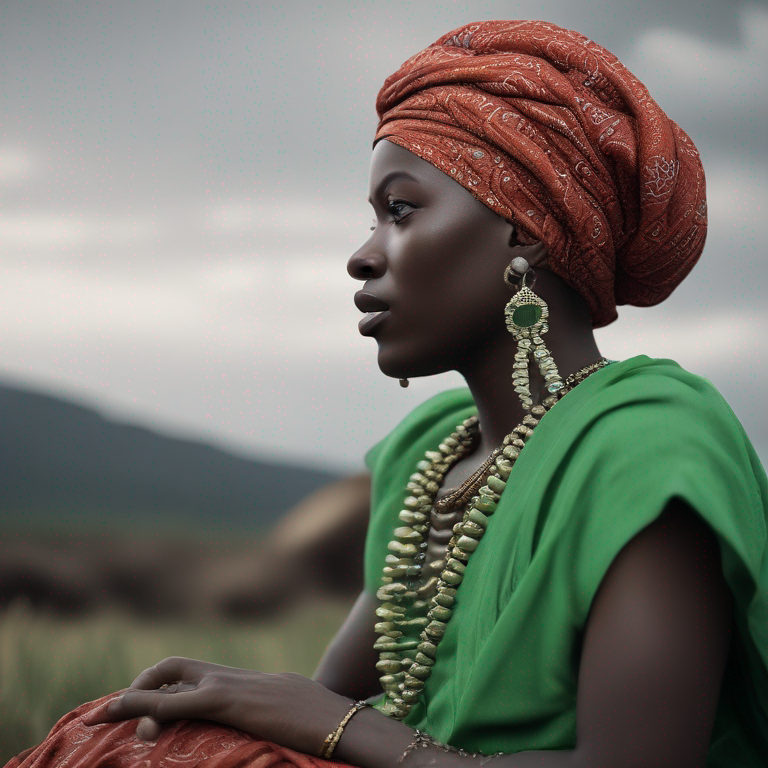
Jewelry from Nigeria: A Journey Through Cultural Heritage, Exquisite Craftsmanship, and Artistic Expression
Unveiling the Beauty and Significance of Exquisite Adornments
Nigeria, a vibrant and diverse nation in West Africa, boasts a rich cultural heritage deeply intertwined with the art of jewelry making. From ancient traditions passed down through generations to modern interpretations that push creative boundaries, Nigerian jewelry embodies the spirit of the land, its people, and their enduring connection to beauty and self-expression.
A Tapestry of Tribal Traditions:
Nigeria is home to over 250 ethnic groups, each with its unique cultural heritage and distinct traditions in jewelry making. This diversity manifests in a vast array of designs, materials, and techniques, creating a tapestry of artistic expressions that reflect the rich cultural landscape of the nation.
-
The Yoruba: Renowned for their intricate beadwork, the Yoruba people of southwestern Nigeria create stunning jewelry pieces using colorful beads, shells, and precious metals. Their beaded necklaces, bracelets, and crowns are often adorned with symbolic motifs that represent proverbs, ancestral connections, and social status.
-
The Igbo: The Igbo people of southeastern Nigeria are celebrated for their mastery of bronze casting. Their intricate bronze ornaments, masks, and sculptures showcase their exceptional artistry and technical skill. Igbo jewelry often features geometric patterns, human figures, and animal motifs, reflecting their connection to nature and their belief system.
-
The Hausa: The Hausa people of northern Nigeria are known for their elegant silver and gold jewelry. Their intricate filigree work, delicate chains, and elaborate earrings are often adorned with precious stones and coral, reflecting their appreciation for beauty and craftsmanship.
-
The Fulani: The Fulani, a nomadic pastoralist group scattered throughout West Africa, are renowned for their vibrant beadwork and leather jewelry. Their colorful necklaces, bracelets, and amulets are often adorned with cowrie shells and intricate beadwork, reflecting their connection to their livestock and their nomadic lifestyle.
-
The Edo: The Edo people of southern Nigeria are celebrated for their mastery of ivory and coral carving. Their intricate ivory bracelets, necklaces, and masks showcase their exceptional artistry and technical skill. Edo jewelry often features geometric patterns, human figures, and animal motifs, reflecting their connection to nature and their belief system.
Materials and Techniques: A Celebration of Craftsmanship
Nigerian jewelry is crafted using a diverse range of materials, from precious metals like gold and silver to natural materials like beads, shells, and leather. Each material offers unique aesthetic qualities and opportunities for creative expression, reflecting the ingenuity and resourcefulness of Nigerian artisans.
-
Gold and Silver: Gold and silver have been prized materials for jewelry making in Nigeria for centuries. These precious metals are often used to create intricate designs, delicate chains, and elaborate ornaments, showcasing the exceptional craftsmanship and artistic skill of Nigerian goldsmiths.
-
Bronze and Brass: Bronze and brass are widely used materials for casting intricate sculptures, masks, and ornaments. These metals offer durability and a unique patina that adds a touch of古色古香to the finished pieces.
-
Beads: Beads, made from glass, wood, or plastic, are a staple material in Nigerian jewelry making. They are used to create vibrant necklaces, bracelets, and headpieces, often featuring intricate patterns, symbolic motifs, and colorful combinations that reflect the wearer's cultural heritage and personal style.
-
Shells and Coral: Shells and coral are natural materials often incorporated into Nigerian jewelry, adding a touch of organic beauty and cultural significance. These materials are used to create necklaces, bracelets, and earrings, often featuring intricate designs and symbolic motifs that represent the wearer's connection to the sea and their cultural heritage.
-
Leather and Fabric: Leather and fabric are used to create practical and stylish jewelry pieces, often incorporating traditional beadwork, embroidery, and other decorative techniques. These materials offer comfort, durability, and a unique aesthetic that complements both traditional and modern styles.
Beyond Adornment: The Deeper Significance of Jewelry in Nigeria
Nigerian jewelry transcends its role as mere adornment; it serves as a powerful symbol of cultural identity, social status, and spiritual beliefs. Each piece carries a deeper meaning and reflects the wearer's connection to their community, their ancestors, and the rich cultural heritage of their nation.
-
Cultural Identity: Jewelry is often used as a visible expression of cultural identity in Nigeria. The designs, materials, and techniques used in jewelry making vary significantly among different ethnic groups, allowing individuals to showcase their heritage and connect with their ancestral traditions.
-
Social Status: Jewelry can also denote social status and wealth in Nigerian society. Ornate gold and silver ornaments, elaborate beaded necklaces, and intricate bronze sculptures often signify the wearer's position within their community and their access to resources.
-
Spiritual Beliefs: Jewelry is often imbued with spiritual significance in Nigerian cultures. Amulets, charms, and talismans are believed to possess protective powers, bring good luck, or ward off evil spirits. These pieces are often worn as a way to connect with the spiritual realm and seek protection from harm.
A Modern Renaissance: Innovation and Contemporary Interpretations
While traditional techniques and designs remain deeply cherished in Nigerian jewelry making, a new generation of artisans is pushing creative boundaries and exploring contemporary interpretations of this ancient art form.
-
Fusion of Tradition and Modernity: Modern Nigerian jewelry designers are incorporating traditional motifs, materials, and techniques into contemporary designs, creating unique pieces that bridge the gap between heritage and innovation.
-
Experimentation with Materials and Techniques: Artists are exploring new materials such as recycled metals, acrylics, Acrylics in traditional and innovative casting techniques with materials such as metals, and acrylics casting create bold experimental jewelry pieces that challenge push modern
